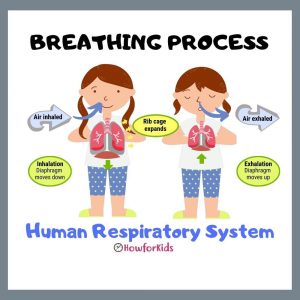Our planet is inhabited by a great diversity of animals. We will explain in a simple way what are vertebrates and invertebrates for kids and their characteristics.
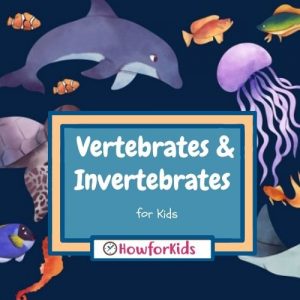
Fun Facts About Vertebrate and Invertebrate Animals
Table of Contents
Aristotle, a Greek scientist and philosopher who lived in the 4th century BC, was the first to devise a way to classify living things.
Aristotle’s system was based on complexity. He organized living organisms according to their complexity, from the lowest (small invertebrates) to the highest (human beings).
The classifications were based on the observable characteristics of these organisms.
Aristotle divided animals into two types: those with blood and those without blood. This division corresponds closely to the division between vertebrates and invertebrates that is used today. He organized groups of animals with similar characteristics and called them genera.
Within the blooded animals, there were five genera. Let’s see what are the differences and characteristics of each group.
Animal Classification for Children
What are Vertebrate and Invertebrate Animals?
Classifying Vertebrates and Invertebrates for Kids
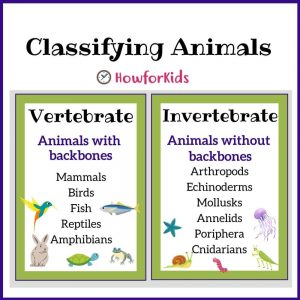
Vertebrates are those animals that have an articulated internal skeleton, either bony or cartilaginous. That internal skeleton is made up of a spinal column and other bones.
Main Characteristics of the Vertebrates
- Presence of vertebral column formed by vertebrae. Its function is to support the body, protect and support the spinal cord of the nervous system. It acts as a support for the body to facilitate movement. Cartilage binds bones allowing mobility at the joints. Vertebrate animals are characterized by bilateral symmetry and a skull that protects the brain.
- Parts of the body: The body of vertebrate animals is divided into three zones: head, trunk and limbs. Some species also have a tail.
- Sex differentiation. In other words, there are male individuals and female individuals.
- Bilateral symmetry: This means that when dividing the body in half vertically, (right half and left half), both halves are equal.
Also Read: Human Body Systems and Organs
Classifying Vertebrates
Comparative Anatomy of Vertebrates
Vertebrate animals are classified into five groups. They are:
- Mammals
- Birds 🐦
- Fishes
- Amphibians
- Reptiles

1. Mammal Animals for Kindergarten Kids
The body of mammals is covered with hairs. Some are aquatic, others terrestrial. They develop inside the female’s body.
Mammals: Characteristics
- Skin: Their skin is covered with hair.🐄
- They are viviparous with few exceptions. What does viviparous mean? It means that the development of their young takes place inside the “belly” of the mother. Inside the female. On the other hand, when they develop from eggs outside the mother’s body, such as birds do, they are called oviparous.
- Limbs: Their limbs are generally made up of four legs that allow them to move. Aquatic mammals (such as dolphins or whales) have fins on their extremities and flying mammals (such as bats) have membranes on their forelimbs that serve as wings.
- Feeding: They feed by sucking milk from their mother. Females present mammary glands to feed their newborn pups with milk (lactation).
- Body temperature: Their body temperature is constant. This means that it does not vary according to the temperature of the medium in which they are found. They are warm-blooded animals.
- Respiration: Mammals breathe through lungs, even if they live in the sea.
Fun Facts about Mammals
As with any rule, there are exceptions. Here are some exceptions related to the characteristics of mammals:
- Mammals without hairs: Dolphins.
- Mammals with wings that fly: Bats.
- Mammals with fins that swim: Whales.
- Mammal with beak that lay eggs: Platypus.
A few examples of mammals: Antelope, goat, horse, kangaroo, pig, cat, monkey, sheep, dog, cow.
Mammals: Classification
The main orders in which Mammals are classified are:
- Artiodactyls (deer, camel, pigs, cows, sheep, hippo)
- Carnivores (cat, tiger, bears like panda, polar bear )
- Cetaceans (whale, dolphins)
- Toothless (sloth)
- Insectivores (insect – eaters: hedgehog, moles, shrews )
- Lagomorphs (rabbit, hare, pika)
- Marsupials (kangaroos)
- Monotremes (platypus)
- Pinnipeds (seal)
- Primates (monkeys, chimpanzees, humans)
- Proboscidea (elephants, mammoths, mastodonts)
- Chiroptera (bats)
- Rodentia (rats, mice, hamsters)
- Sirenia (sea cow, manatees)
2. Birds
Bird Characteristics
- Their bodies are covered with feathers.
- Their forelimbs are shaped like wings. Birds fly thanks to the movements of their wings, although some birds are not able to fly, such as ostriches and penguins.
- The skeleton of birds is very light because the bones are hollow. Some birds have air sacs that are full of air to facilitate flight.
- Their body temperature is constant, that is, they are warm-blooded animals.
- They breathe through their lungs.
- The mouth has a toothless beak that varies greatly from one species to another depending on their diet.
3. Fish
Fish Characteristics
- Their bodies are covered in scales.🐡
- They are oviparous.
- Their limbs are shaped like several fins. Their bodies end in a tail-shaped fin.
- Their skeleton is simpler than that of vertebrates. The bones are shaped like spines. Some fish like shark and ray have cartilaginous skeletons.
- The body temperature depends on the temperature of the water. They are cold-blooded animals.
- They breathe through gills instead of lungs that are located behind the head. They allow them to obtain the dissolved oxygen in the water.
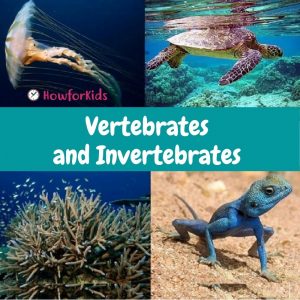
4. Amphibians Characteristics
- Their skin is bare and wet.
- They are oviparous.
- Their limbs are four muscular legs or none. The body temperature is variable. They are cold-blooded animals.
- Their young are born in water and breathe through gills. As adults, when they live on land and in water, breathe through the skin and through the lungs.
5. Reptiles Characteristics
- Their bodies are covered in scales.
- They are oviparous, that is to say, they reproduce by eggs. Some reptiles, such as the viper, are ovoviviparous: The eggs hatch inside the mother’s body and living young are born.
- Their limbs are shaped like four legs, or none like snakes.
- The body temperature is variable. They are cold-blooded animals.
- Their respiration is pulmonary.
Read Also: Respiratory System in Human
Examples of Vertebrate Animals
- Horse
- Camel
- Canary
- Kangaroo
- Chinchilla
- Rabbit
- Dromedary
- Elephant
- Cat
- Gorilla
- Hippopotamus
- Iguana
- Goldfinch
- Giraffe
- Lion
- Lynx
- Parrot
- Monkey
- Sheep
- Panther
- Dog
- Frog
- Rat
- Mouse
- Rhinoceros
- Shark
- Tiger
- Cow
Characteristics of Invertebrate Animals
Invertebrates belong to a very varied group of animals that are characterized by not having vertebrae, no vertebral column or articulated internal skeleton. They are usually small in size and most have an external skeleton called an exoskeleton in the form of a shell or shell that protects them. Invertebrates are found in various environments. Some live in terrestrial environments while others are aquatic. Most invertebrates are oviparous, that is, they reproduce by means of eggs. Although there are also a large number of asexual invertebrates.
Invertebrates: Classification
Invertebrates are classified into six main groups:
1. Arthropods
They have a body formed by a rigid external skeleton that provides support and protection and articulated legs. Some have wings. They are classified as: Insects, arachnids, myriapods and crustaceans.
- Insects have three pairs of legs, some have wings like flies.
- Arachnids have four pairs of legs (spiders, scorpions).
- Myriapods have a segmented body and more than 15 pairs of legs (centipedes).
- Crustaceans have between five and ten pairs of legs (shrimp and pellet, crabs and sea lobsters).
2. Mollusks
They have a soft body without legs. They can be terrestrial or aquatic. They may have a hard outer shell (snails) or an inner shell (clams, mussels, squid) or not (octopus and slugs). They are divided into three groups: gastropods, bivalves and cephalopods.
3. Annelids or Earthworms
There are three types:
- Platyhelminths: they are flatworms.
- Nematoda: they are round or cylindrical worms.
- Annelids: their bodies are divided into rings (earthworms). They can inhabit water or land, their body is soft.
4. Echinoderms (sea urchins and starfish)
They are marine animals with radial symmetry, like the wheel of a bicycle. They move around using a system called the ambulatory system. Starfish have an external skeleton made of limestone plate with five arms. They may have hard spines that protrude from the body. Its body is flattened and in its lower part is the mouth.
5. Cnidarians
They are aquatic invertebrates, characterized by having a soft, gelatinous and transparent body that floats in the water. Its tentacles secrete toxic substances capable of causing irritation. (Jellyfish, anemones, hydras, corals and polyps).
6. Porifera (sponges)
Although it looks like a plant, it is a very simple animal shaped like a sack. It has an upper hole and lateral pores. Their habitat is water and they live attached to rocks. The water is filtered through their pores where it retains the substances that will serve as food.
List of Invertebrate Animals: Examples of Invertebrate Animals for Kids
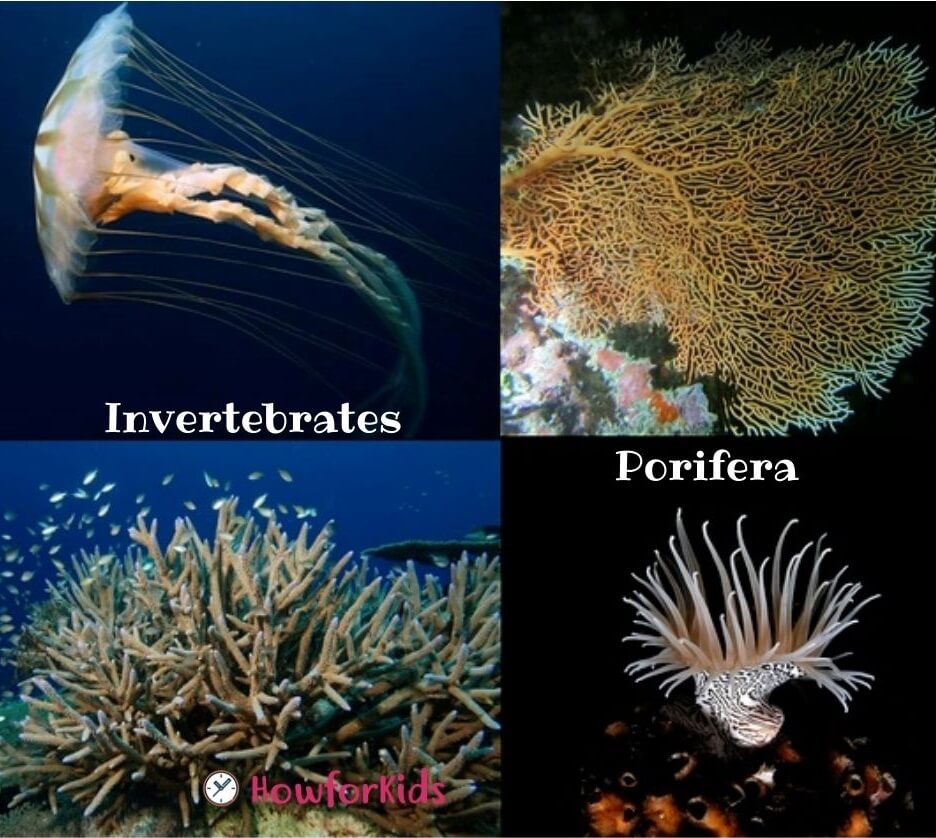
- Octopus
- Mosquito
- Bee
- Ant
- Spider
- Jellyfish
- Sea urchin
- Snail
- Coral
- Land slug
- Oyster
- Mussel
- Giant squid
- Scorpion
- Dragonfly
- Crab
- Locust
- Cricket
- Grasshopper
- Fly
- Butterfly
Difference between Viviparous, Oviparous and Ovoviviparous Animals
Viviparous Animals
The embryo develops inside the mother’s womb. It is one of the three kinds of sexual reproduction of animals (most characteristic of mammals).
Oviparous Animals
They are those animals whose reproduction is carried out by means of. They finish their development on the outside unlike the viviparous ones that do it inside their mother.
Ovoviviparous
They have aspects in common with both the oviparous and the viviparous. Ovoviviparous are those animals that lay eggs, but these remain inside the mother until they are fully developed. The hatching of the eggs in this kind of reproduction can take place before parturition or after, depending on the species. It is the reproduction of some invertebrates and reptiles.

